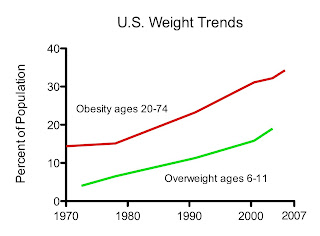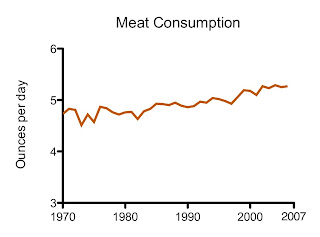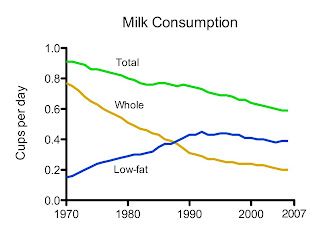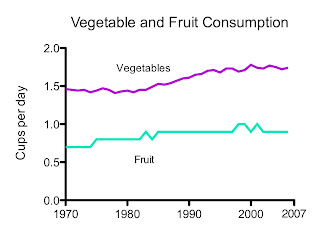For this post, I compiled statistics on U.S. weight, health and lifestyle trends, and graphed them as consistently as possible. They span the period from 1970 to 2007, during which the obesity rate doubled. The data come from the National Health and Nutrition Examination Survey (NHANES), the Behavioral Risk Factor Surveillance System (BRFSS), and the U.S. Department of Agriculture (USDA). Some of the graphs are incomplete, either because the data don’t exist, or because I wasn’t able to find them. 
Obesity is defined as a body mass index (BMI) of 30+; overweight is a BMI of 25+. Yes, it’s frightening. It has affected adults and children (NHANES).

The percentage of Americans who report exercising in their spare time has actually increased since 1988 (BRFSS).
We’re eating about 250 more calories per day, according to NHANES.

The 250 extra calories are coming from carbohydrate (NHANES).
We’re eating more vegetables and fruit (USDA).

We’re eating more meat by weight, although calories from meat have probably gone down because the meat has gotten leaner (USDA). This graph represents red meat, fish and poultry. The increase comes mostly from poultry. Boneless, skinless chicken breasts anyone?

We’re eating more sugar (USDA). The scale of the graph doesn’t allow you to fully appreciate that sweetener consumption had increased by a full 100 calories per day by 1999, although it has dropped a bit since then. This is based on food disappearance data. In other words, the amount consumed is estimated using the amount sold domestically, minus a percentage that approximates waste. High-fructose corn syrup has seized nearly 50% of the sweetener market since 1970.

Again, the scale of the graph doesn’t allow you to fully appreciate the magnitude of the change here. In 2000, we ate approximately 2.5 ounces, or 280 calories, more processed grains per day than in 1970 (USDA). That has since decreased slightly (34 calories). You might be saying to yourself right now “hey, that plus the 100 calories from sugar adds up to more of an increase than the NHANES data show!” Yes, and I think that points to the fact that the data sets are not directly comparable. NHANES data are self-reported whereas USDA data are collected from vendors. Regardless of the absolute numbers, our processed grain consumption has gone way up since 1970.
Wheat is still king. Although we grow a lot of corn in this country, most of it gets fed to animals. We prefer eating wheat without first feeding it to an intermediary. In absolute quantity, wheat consumption has increased more than any other grain (not including corn syrup).
 Bye bye whole milk. Hello skim milk (USDA).
Bye bye whole milk. Hello skim milk (USDA).
This graph represents “added fats”, as opposed to fats that occur naturally in meat or milk (the USDA does not track the latter). Added fats include salad oil, cooking oil, deep fry oil, butter, lard, tallow, etc. We are eating a lot more vegetable oil than we were in 1970. It comes chiefly from the industrial, omega-6 rich oils such as soybean, corn and canola. Added animal fats have increased slightly, but it’s pretty insignificant in terms of calories.
There is an artifact in this graph that I have to point out. In 2000, the USDA changed the way it gathered vegetable oil data. This led to an abrupt, apparent increase in its consumption that is obvious on the graph. So it’s difficult to make any quantitative conclusions, but I think it’s clear nevertheless that vegetable oil intake has increased considerably.
Between 1970 and 1980, something changed in the U.S. that caused a massive increase in obesity and other health problems. Some combination of factors reached a critical mass that our metabolism could no longer tolerate. The three biggest changes in the American diet since 1970:
- An increase in cereal grain consumption, particularly wheat.
- An increase in sweetener consumption
- The replacement of meat and milk fat with industrial vegetable oils, with total fat intake remaining the same.
Mainstream America has done to itself what it did to native American and other indigenous cultures worldwide, with the same result.
Source: Whole Health Source












